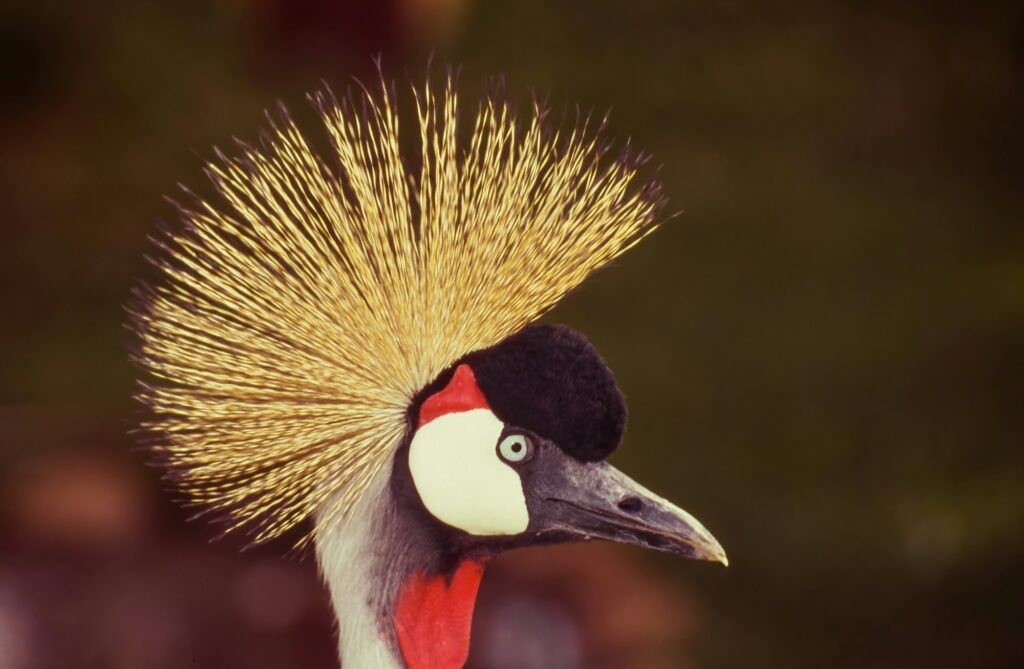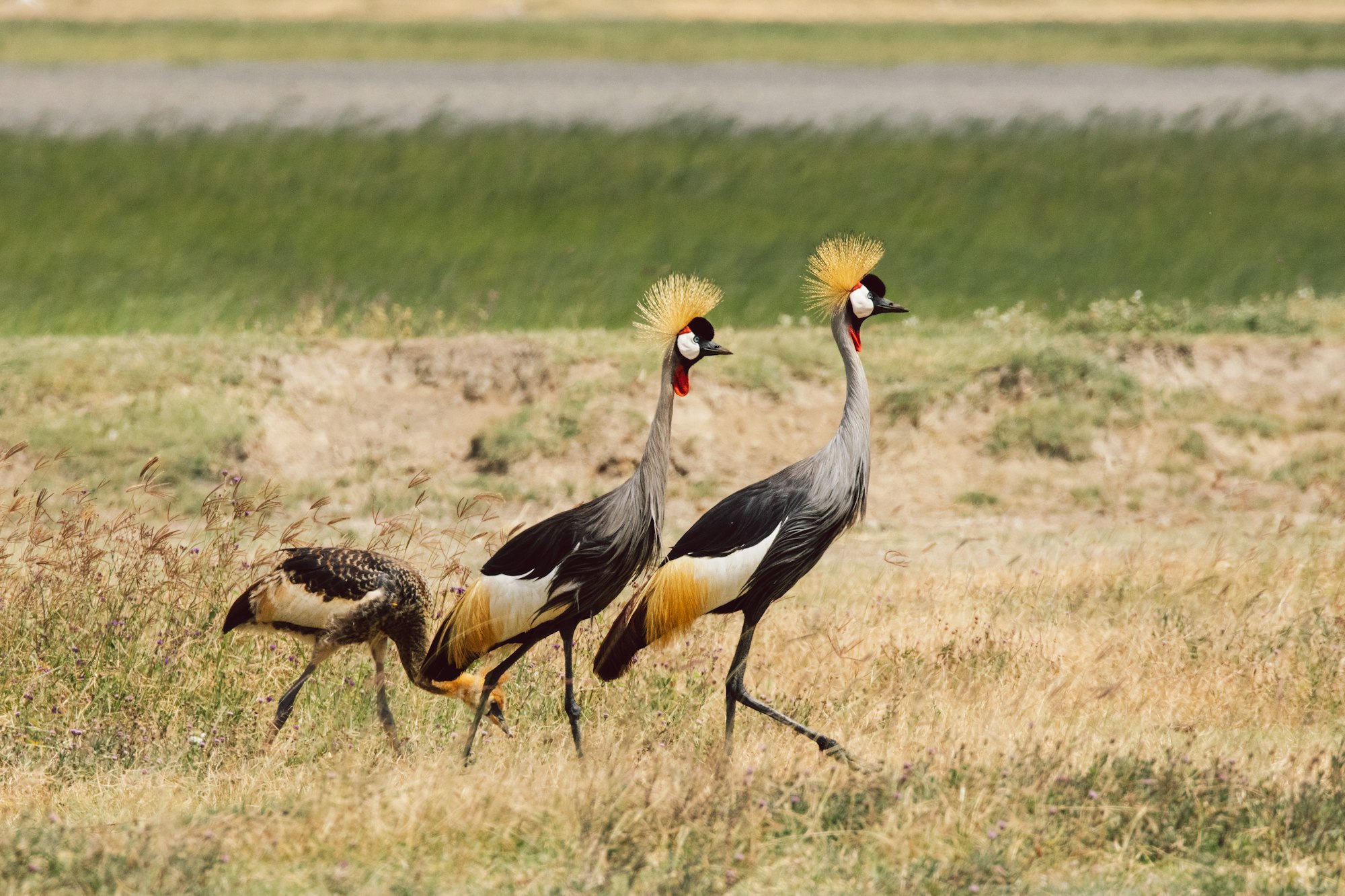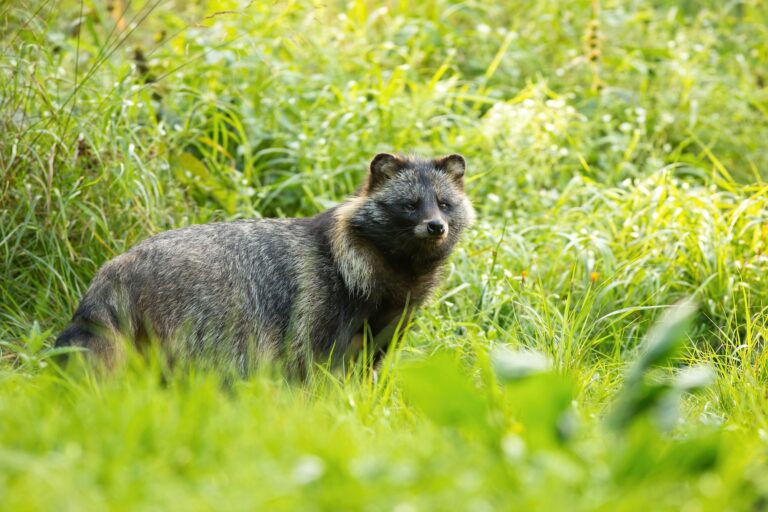The pictures we use in our articles might not show exactly what the words say. We choose these pictures to make you interested in reading more. The pictures work together with the words but don’t take their place. The words still tell you the important facts.
The Grey crowned crane (Balearica regulorum) is a magnificent bird that graces the grasslands and wetlands of Africa with its regal presence. As Uganda's national bird, this elegant creature captivates wildlife enthusiasts and researchers alike with its unique appearance and fascinating behaviors. In this comprehensive guide, we'll explore the world of the Grey crowned crane facts, uncovering its distinctive features, habitat, behavior, and conservation status.
1. Appearance and Physical Characteristics
The Grey crowned crane is a sight to behold, standing tall at up to 3.3 feet (1 meter) with a wingspan of around 6.5 feet (2 meters). Its most striking feature is the golden crown of stiff feathers adorning its head, which gives the bird its regal appearance. The body plumage is predominantly grey, while the wings showcase a variety of colors with a distinctive black patch at the top.
Other notable physical characteristics include:
- A bright red inflatable throat pouch
- White sides of the face
- A relatively short, grey bill
- Long, black legs adapted for wading
- Large, slender feet for balance
Male and female Grey crowned cranes are similar in appearance, though males tend to be slightly larger. Younger cranes have a more greyish plumage and a feathered buff face.

2. Habitat and Distribution
Grey crowned cranes are primarily found in the wetland areas of sub-Saharan Africa. Their range includes:
These birds prefer dry savannah habitats but nest in wetter areas. They can also be found in marshes, cultivated lands, and grassy flatlands near rivers and lakes. Unlike some crane species, Grey crowned cranes do not have set migration patterns. Birds closer to the tropics tend to be sedentary, while those in more arid regions, such as Namibia, may make localized seasonal movements during drier periods.
3. Behavior and Social Structure
Grey crowned cranes are known for their fascinating behaviors and social interactions. Here are some key aspects of their behavior:
Territorial Nature
During the breeding season, these cranes become fiercely territorial. They use loud calls and elaborate dance-like displays to ward off intruders and assert dominance over their nesting sites.
Courtship Dance
One of the most captivating behaviors of the Grey crowned crane is its courtship dance. This elaborate ritual involves:
- Hopping
- Wing flapping
- Bowing
Both males and females participate in this mesmerizing display, which not only demonstrates their strength and agility but also helps to solidify the bond between mating pairs.
Vocalizations
Grey crowned cranes are known for their distinctive vocalizations. They have a booming call that involves inflating their red gular sac. Additionally, they make a honking sound that sets them apart from the trumpeting calls of other crane species.
Flocking Behavior
While they can be territorial during breeding, Grey crowned cranes are social birds. Flocks of 30-150 birds are not uncommon, showcasing their gregarious nature.
4. Diet and Feeding Habits
The Grey crowned crane is an omnivorous bird with a diverse diet. Their food sources include:
These birds have developed an interesting feeding technique. They stamp their feet as they walk, flushing out insects which they quickly catch and eat. Grey crowned cranes also often associate with grazing herbivores, taking advantage of the prey items disturbed by antelopes and gazelles.
5. Breeding and Reproduction
The breeding habits of Grey crowned cranes are closely tied to rainfall patterns, though this varies geographically:
- In East Africa: They breed year-round, with higher frequency during drier periods.
- In Southern Africa: The breeding season coincides with the rainy season.
During the breeding season, pairs construct large nests in tall wetland vegetation. These platforms are made of grass and other plant materials. The female typically lays a clutch of 2-5 glossy, dirty-white eggs, which both parents incubate for 28-31 days.
Grey crowned crane chicks are precocial, meaning they can run almost immediately after hatching. They fledge in 56-100 days and become fully independent shortly after.
6. Conservation Status and Threats
Despite their beauty and cultural significance, Grey crowned cranes face several threats in the wild. In 2012, the International Union for Conservation of Nature (IUCN) uplisted the species from vulnerable to endangered.
The main threats to Grey crowned cranes include:
Current estimates place the global population of Grey crowned cranes between 58,000 and 77,000 individuals. Conservation efforts are crucial to ensure the survival of these magnificent birds for future generations.
7. Cultural Significance
The Grey crowned crane holds a special place in African culture, particularly in Uganda, where it is the national bird. It is featured prominently on Uganda's flag and coat of arms, symbolizing the nation's natural heritage and beauty.
In various African cultures, the Grey crowned crane is associated with good luck and longevity. Its elegant appearance and graceful movements have inspired countless artistic expressions, solidifying its place in cultural narratives and folklore across the continent.
8. Unique Adaptations
Grey crowned cranes possess some unique adaptations that set them apart from other crane species:
These adaptations are believed to be ancestral traits among cranes, which have been lost in other subfamilies over time.
FAQs About Grey Crowned Cranes
Q: How long can Grey crowned cranes live?
A: With proper care, these birds can live beyond two decades in the wild and up to 30 years or more in captivity.
Q: Do Grey crowned cranes migrate?
A: Unlike many crane species, Grey crowned cranes don't have set migration patterns. Those in arid areas may make local seasonal movements during dry periods.
Q: What is the significance of the crane’s “dance”?
A: The crane's dance is an integral part of courtship, but it's also performed year-round. It helps strengthen pair bonds and can be a form of social interaction.
Q: Are Grey crowned cranes good parents?
A: Yes, they exhibit excellent parental care. Both males and females incubate the eggs and care for the chicks after hatching.
Q: Why is the Grey crowned crane endangered?
A: The main threats are habitat loss, pollution, and illegal hunting. Conservation efforts are crucial to protect these magnificent birds.
In conclusion, the Grey crowned crane is a remarkable bird that embodies the beauty and diversity of African wildlife. From its distinctive golden crown to its elaborate courtship dances, this species continues to captivate and inspire. As we appreciate their grace and elegance, it's crucial to remember the challenges they face and the importance of conservation efforts to ensure their survival for generations to come.






